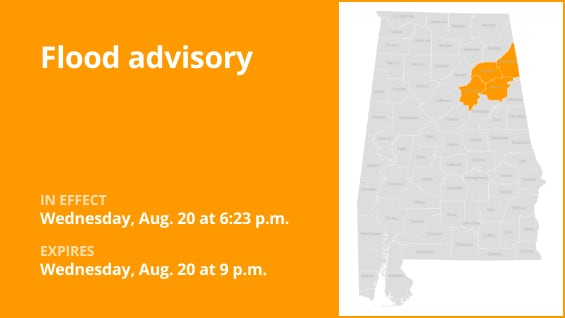The National Weather Service issued a revised flood advisory for Calhoun, Cherokee, Etowah, and St. Clair counties on Wednesday at 6:23 p.m., which is in effect until 9 p.m.
According to the weather service, “Urban and small stream flooding caused by excessive rainfall is expected.”
“Minor flooding in low-lying and poor drainage areas,” the weather agency says to clarify. “When you come across flooded roads, turn around to avoid drowning. The majority of flood fatalities involve automobiles.
Breaking down weather alerts: advisories, watches, and warnings
-
Flash flood warning: Take action!
When a flash flood is either approaching or has already occurred, a warning is given. Moving to higher ground right away is essential in places that are prone to flooding. A flash flood is a quick, intense flood that can form in a matter of minutes to hours and even occur in places that aren’t currently receiving any rain.
-
Flood warning: Take action!
When flooding is about to occur or has already started, a flood warning is issued.
-
Flood advisory: Be aware:
When flooding is not predicted to become severe enough to warrant a warning, a flood advisory is issued. However, it still has the potential to be extremely inconvenient and, if careless, to result in circumstances that endanger life and/or property.
-
Flood watch: Be prepared:
When the weather is conducive to flooding, a flood watch is issued. Flooding is not guaranteed, but it is a possibility.
Staying safe during a flood: Recommendations from the weather service
Knowing and adhering to the weather service’s flood safety recommendations can be extremely helpful when camping in low-lying areas or in locations that are prone to flooding:
Go to a higher location:
Moving to higher ground should be your first course of action if you’re camping in a low-lying location or in an area that is prone to flooding.
Observe evacuation directives:
Immediately comply with any evacuation orders issued by local authorities. Make sure your house is locked before you leave.
Cut off appliances and utilities:
Disconnect your appliances and utilities if you have the time. By doing this, the possibility of electrical risks during floods is decreased.
Avoid drowned places and flooding basements:
Stay away from rooms with electrical outlets or cords that are submerged in water or basements. Electrical accident prevention is essential.
Quickly leave for your safety:
Evacuate right away if you see sparks or hear popping, crackling, buzzing, or snapping sounds. Steer clear of any water that might be electrically charged.
Avoid going on foot in floodwaters:
Even if floodwaters seem shallow, you should never try to go over them. You can be swept off your feet with power by just 6 inches of swift-moving water.
If you’re stuck, look for high ground:
If you find yourself caught by flowing water, get to the highest position you can and call 911 to get help.
Flooding may occur during periods of intense precipitation, particularly in low-lying and flood-prone locations. Even if the water doesn’t seem deep, you should never drive across it. The weather service claims that most cars can be washed away with just 12 inches of surging water. Be knowledgeable and ready to be safe.
Rainy roadways ahead: Essential safety tips for heavy rain
If heavy rainfall persists or if runoff is substantial, flooding may result. Saturated soils and/or heavy rainfall can cause excessive runoff. To keep safe during periods of intense rain, heed these weather service recommendations:
Watch out for swift water flow:
Avoid parking or strolling close to culverts or drainage ditches during periods of intense precipitation, as the swift-moving water can be quite dangerous.
Keep your distances from other vehicles safe:
In heavy rain, the two-second rule of following distance is your friend. To guarantee safe spacing under unfavorable circumstances, increase it to four seconds.
Slow down and drive carefully:
Lowering your speed is essential on wet roads. To prevent skidding, reduce the accelerator gradually rather than braking suddenly.
Pick your lane carefully:
Water tends to pool in the outside lanes, so stick to the central ones.
Put visibility first:
As rain-spattered windows make it more difficult to see other vehicles, turn on your headlights and pay attention to those in blind spots and behind you.
Be cautious on slick roads:
During the first half hour after the rain starts, exercise additional caution. The road becomes slick when water combines with dirt and oil on the surface.
Stay a safe distance away from big cars:
Avoid following buses or big vehicles too closely. Their big tires produce a mist that blurs your eyesight. Additionally, if you have to pass them, proceed with caution.
Be mindful of your wipers:
-
Heavy rain can overload the wiper blades. When visibility is so limited that the edges of the road or other vehicles cannot be seen at a safe distance, it is time to pull over and wait for the rain to ease up. It is best to stop at rest areas or other protected areas.
-
If the roadside is your only option, pull off as far as possible, preferably past the end of a guard rail, and wait until the storm passes. Keep your headlights on and turn on emergency flashers to alert other drivers of your position.
Taking these safety measures will significantly improve your road safety while it’s raining a lot. For a safe trip, keep yourself updated on weather conditions and follow local authorities’ instructions.
United Robots offers a service called Advance Local Weather Alerts that gathers the most recent information from the National Weather Service using machine learning.






